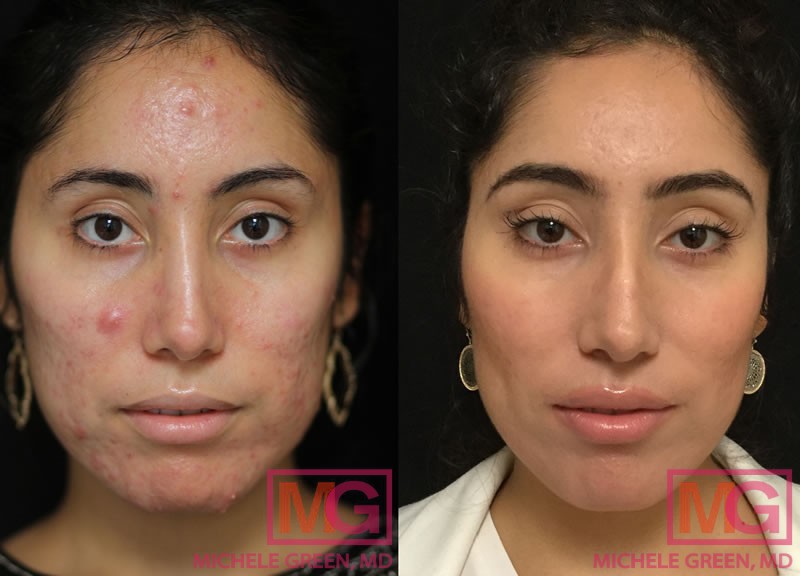Subcision for Acne Scarring
Subcision for acne scar treatment is a popular procedure at the private NYC dermatology office of Dr. Michele Green. Acne scars result from unresolved acne, leaving the skin damaged. Acne is one of the most common skin conditions in the United States, affecting up to 50 million Americans each year. Severe inflammatory acne breakouts, such as cysts, papules, and pustules, can turn into scars if not treated, and these scars can be harder to eliminate than the original acne. Depending on how the skin heals, acne can cause atrophic scars—formed by depressions on the skin’s surface due to insufficient collagen production during healing; hypertrophic scars—raised scars caused by excess collagen; or skin discoloration and hyperpigmentation. Without treatment, acne scars are permanent and can cause many patients to feel self-conscious. Luckily, board-certified dermatologist Dr. Michele Green in NYC specializes in removing acne scars and offers various treatment options for all types of acne scarring.
Patients with atrophic acne scars can consider subcision, a minor dermatologic surgery aimed at reducing skin depressions. Also called subcutaneous incisionless surgery, subcision is especially effective for two types of atrophic scars: boxcar scars, which are round or oval depressions, and rolling scars, which produce a wavy, uneven skin surface. The procedure uses a hypodermic needle to cut the fibrous bands in the tissue beneath the skin, causing an immediate lift and boosting the body’s natural collagen production, which results in smoother skin over time. When combined with other in-office treatments like dermal fillers, microneedling, chemical peels, TCA cross, CO2 laser resurfacing, fractionated laser resurfacing, or radiofrequency laser therapy, subcision becomes a highly effective option for treating atrophic scars.
Dr. Michele Green, based in New York City, is an internationally recognized, board-certified dermatologist with over 25 years of experience. She offers discerning men and women the finest skincare and minimally invasive cosmetic treatments, such as subcision for acne scars. Dr. Green’s dedication to her patients and her expertise have earned her consistent recognition as one of New York’s top dermatologists by Castle Connolly, New York Magazine, and Super Doctors. She takes a holistic approach to facial rejuvenation. She follows a ‘less is more’ philosophy, customizing each treatment plan to include a unique combination of specially formulated skincare products and in-office procedures that best address each patient’s specific concerns and aesthetic goals.
What is Subcision Acne Scar Treatment?
Subcision for acne scar treatment, also called subcutaneous incision-less surgery, is a safe and effective option for treating depressed acne scars. Atrophic acne scars are a type that subcision can help improve. These scars form when the skin doesn’t produce enough collagen to repair the damage, leading to a sunken scar. Instead, these atrophic scars develop fibrous tissue during healing, which pulls the skin downward.
Subcision is classified as a surgical procedure but doesn’t involve making cuts on the skin’s surface. Instead, a Nokor needle, Taylor liberator, or blunt cannula is inserted into the dermis directly beneath the scar to break the fibrotic strands that connect the skin’s surface to the underlying scar tissue. This method immediately lifts the skin and triggers the body’s natural healing process, encouraging collagen production over time. While mainly used to treat depressed scars, the procedure can also help diminish the appearance of wrinkles and cellulite on the face and body. Typically, multiple sessions are needed for the best results. Once the fibrous bands are broken, the skin is stimulated to produce new collagen and elastic fibers, helping the area heal with a smoother, more even texture. When combined with dermal fillers, the filler is injected into the depressed scar to restore lost volume and improve its appearance. Dr. Green’s unique technique of subcision and filler injection provides enhanced results after a single treatment.
Dermal fillers combined with subcision to treat acne scars
Subcision is a highly effective cosmetic procedure for breaking apart the fibrotic strands that tether depressed scars to the skin’s surface. However, subcision alone is often insufficient to fully reduce the appearance of depressed acne scars. Dr. Green frequently uses dermal fillers along with the subcision procedure to address volume loss and stimulate collagen growth in the treated area. They can be injected directly into isolated scars or into larger areas like the cheeks or temples to decrease volume loss and create a smoother appearance. Common fillers used for acne scars include Sculptra, Juvederm, and Restylane.
Sculptra is a unique dermal filler composed of a substance called poly-L-lactic acid, which stimulates new collagen production in the treated area once injected. Over time, as new collagen is produced, the skin texture becomes smoother, reducing the appearance of depressed scars. A short series of three Sculptra treatment sessions is usually required to achieve optimal results. It takes 4 to 6 weeks to see the effect of each Sculptra treatment, and results last up to two years. Most patients engage in regular follow-up treatment sessions on an annual basis to maintain ideal results.
Subcision with hyaluronic acid dermal fillers such as Juvederm and Restylane is another effective option for treating acne scars. Hyaluronic acid is a naturally occurring substance in the skin that helps with hydration and a youthful look. These dermal fillers are also commonly used to reduce wrinkles, restore lost volume, and enhance specific facial features. Hyaluronic acid fillers give immediate results that usually last between 6 and 18 months. This subcision method is very effective because it offers the immediate benefit of restoring volume to scars through the injectable filler, along with the long-term advantage of stimulating new collagen production for lasting rejuvenation. When you see Dr. Green at her private dermatology practice in NYC, she will physically assess your skin condition and review your concerns and aesthetic goals to develop a personalized acne scar treatment plan tailored to your needs.
Does subcision work for Acne scars?
Yes, subcision is effective for scars, especially for atrophic scars that appear depressed, like rolling and boxcar scars. These scars form due to inflammation, which causes the wound healing process to produce fibrous tissue instead of enough collagen. This fibrous tissue pulls the skin inward, creating a pit. While subcision works well for certain types of scars, it is not suitable for hypertrophic or keloid scars caused by excess collagen. Other treatments, such as the VBeam laser or intralesional cortisone injections, may be better options for these keloidal scars. To learn how to properly treat your scars and determine if subcision is right for you, it’s best to consult a board-certified dermatologist like Dr. Michele Green in NYC to find the best approach.
Types of Acne Scars:
Two main types of scars result from acne: atrophic and hypertrophic. Both develop due to different levels of collagen production during healing. Atrophic scars, caused by insufficient collagen, create indentations on the skin’s surface. There are three subtypes of atrophic scars: ice-pick, boxcar, and rolling scars.
Ice-pick scars occur when an infected breakout happens deep within the skin. They are typically small, deep, and narrow, making them challenging to treat.
Boxcar scars are identified by shallow, wide, oval, or round depressions on the skin. They form when inflammatory acne damages the fibrous bands of collagen fibers, leading to a depression caused by a lack of tissue support.
Rolling scars produce a wavy appearance on the skin’s outer layer. Usually shallow, they result from fibrous bands under the skin pulling unevenly on the epidermis.
Hypertrophic scars, on the other hand, result from an overproduction of collagen during healing, causing the scar tissue to appear raised. Collagen-inducing treatments, such as microneedling, are not recommended for hypertrophic scars.
Subcision is most effective for treating boxcar and rolling scars. Both types of scars occur when fibrous bands pull on the skin’s surface, creating depressions. This treatment aims to break the fibrotic strands away from the underlying scar tissue, lifting the skin for a smoother look. However, subcision is not considered suitable for most ice-pick scars, hypertrophic scars, or keloids.
How is acne scar subcision performed?
The first step for any acne scar treatment is to schedule a consultation with an expert dermatologist, Dr. Michele Green. It’s important to choose a board-certified dermatologist, such as Dr. Green, to reduce the risk of complications from surgery and minimize side effects of subcision. Dr. Green will start by examining the treatment area and discussing your aesthetic goals to determine the best treatment or series of treatments for you. If subcision is the right choice, Dr. Green will advise patients to apply a local anesthetic cream one hour before the procedure. Using a topical numbing cream can help lessen potential discomfort during the treatment.
The treatment area will be marked with a surgical pen before starting. Then, Dr. Green will insert an 18- or 20-gauge needle or cannula at an acute angle next to the scar, with the bevel of the needle pointed upwards and parallel to the skin’s surface. The needle is moved in a fanning motion within the dermis to break up the scar tissue and fibrous bands. Patients will immediately notice a skin lift, creating a more even texture. Over time, new collagen production will lead to smoother, tighter skin. Minimal downtime is needed after the procedure, and patients should expect to fully heal within a week. If necessary, Dr. Green may recommend combining subcision with dermal fillers or lasers to add volume to depressions and improve the scars’ cosmetic appearance.
What are the side effects of subcision treatment?
Subcision is a safe and effective option for treating atrophic scars when performed by a skilled, board-certified dermatologist like Dr. Green. This procedure involves minimal downtime and usually causes mild side effects, such as bruising, swelling, and tenderness at the treatment site. These post-treatment side effects typically fade on their own within a week after the procedure. To reduce the risk of bruising, Dr. Green recommends that patients avoid blood thinners and anti-inflammatory medications, such as Advil, Motrin, and Aleve, for one week before the treatment.
Are subcision results permanent?
Yes, subcision is generally considered a permanent treatment for acne scars. Subcision involves breaking up the fibrous bands or tethers that pull down the skin and cause depressed scars. Once these bands are released, the skin can lift away from the face, resulting in a smoother and more even appearance. While the fibrous bands that are broken will stay broken and help improve the look of acne scars, this does not prevent new acne scars from forming. If you are still experiencing active breakouts that lead to acne scars, it is best to consult a board-certified dermatologist, like Dr. Michele Green in NYC, to treat your acne and prevent new scars.
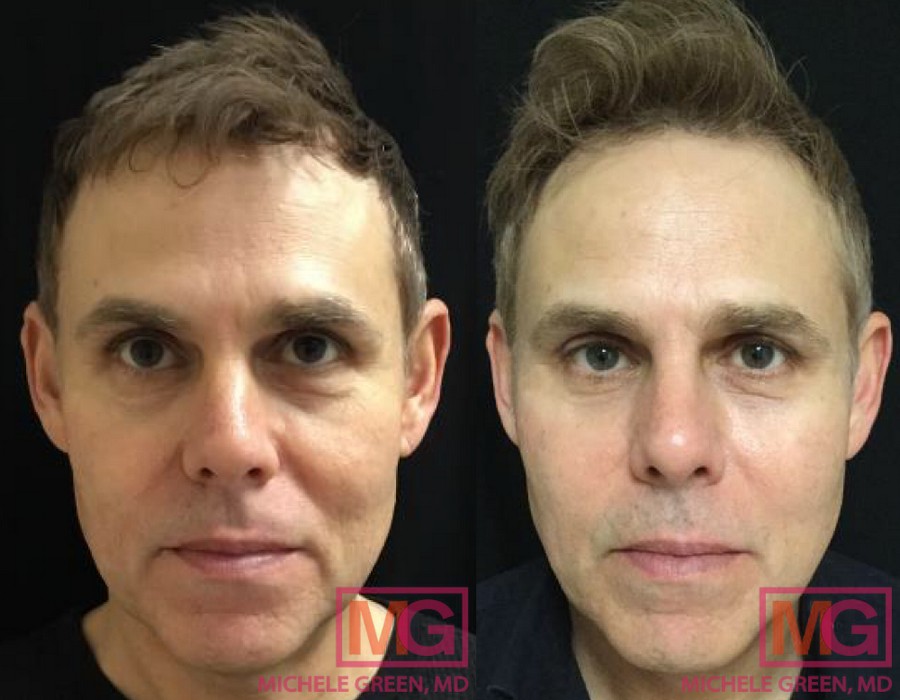
Other Cosmetic Dermatology Treatments for Acne Scars
Acne scar subcision treatment stands out as one of the most effective options for treating depressed acne scars, particularly boxcar scars and rolling scars. Some patients may achieve better outcomes by combining subcision with other in-office treatments, such as dermal fillers, laser resurfacing, radiofrequency laser therapy, microneedling, or chemical peels. Depending on the size and nature of the treatment area, as well as each patient’s unique skin type and aesthetic goals, Dr. Green will recommend the most effective and safest series of treatments.
- Dermal fillers – One of Dr. Green’s most common combinations with subcision for treating acne scars is dermal fillers like Juvederm, Restylane, and Sculptra. These injectable treatments are designed to restore lost volume, making them especially effective for atrophic acne scars (depressed scars) caused by collagen loss that creates indentations in the skin. The procedure involves injecting the filler into the depressed scars, which immediately restores lost volume and stimulates additional collagen production, resulting in firmer, smoother skin that provides lasting results.
- Laser Treatments— Dr. Green may recommend laser treatment along with acne scar subcision to improve the skin’s tone and texture in the treated area. Many laser options are available, including Fraxel, Vbeam, eMatrix, Vivace, eMatrix, and Clear + Brilliant lasers. During your consultation, Dr. Green will select the most suitable laser treatment based on your skin type, tone, and specific concerns. The Fraxel laser minimizes the appearance of acne scars by creating a series of tiny wounds with focused laser pulses. These wounds trigger the body’s natural healing process, boosting collagen production and improving the look of scars over 5 to 6 sessions. The Vivace laser combines radiofrequency and microneedling to stimulate collagen growth and enhance skin texture. Both the eMatrix and Clear + Brilliant lasers are appropriate for all skin types, including darker skin tones, with no risk of hyperpigmentation. The eMatrix uses bipolar radiofrequency to enhance skin tone and texture, while the Clear + Brilliant laser operates like a smaller Fraxel laser, utilizing fractionated laser technology to promote collagen production and reduce pigmentation.
- VBeam Laser –The VBeam laser is ideally used to treat broken blood vessels and reduce redness related to acne scars or post-inflammatory hyperpigmentation. It uses pulsed dye technology with a 595-nanometer wavelength to target blood vessels and red pigments in the skin, effectively decreasing visible redness from acne and surgical scars. Once blood vessels are treated, scars tend to improve in appearance. Additionally, VBeam laser treatment can stimulate new collagen growth and flatten the skin in the affected area. Multiple sessions are needed to improve the look of acne scars.
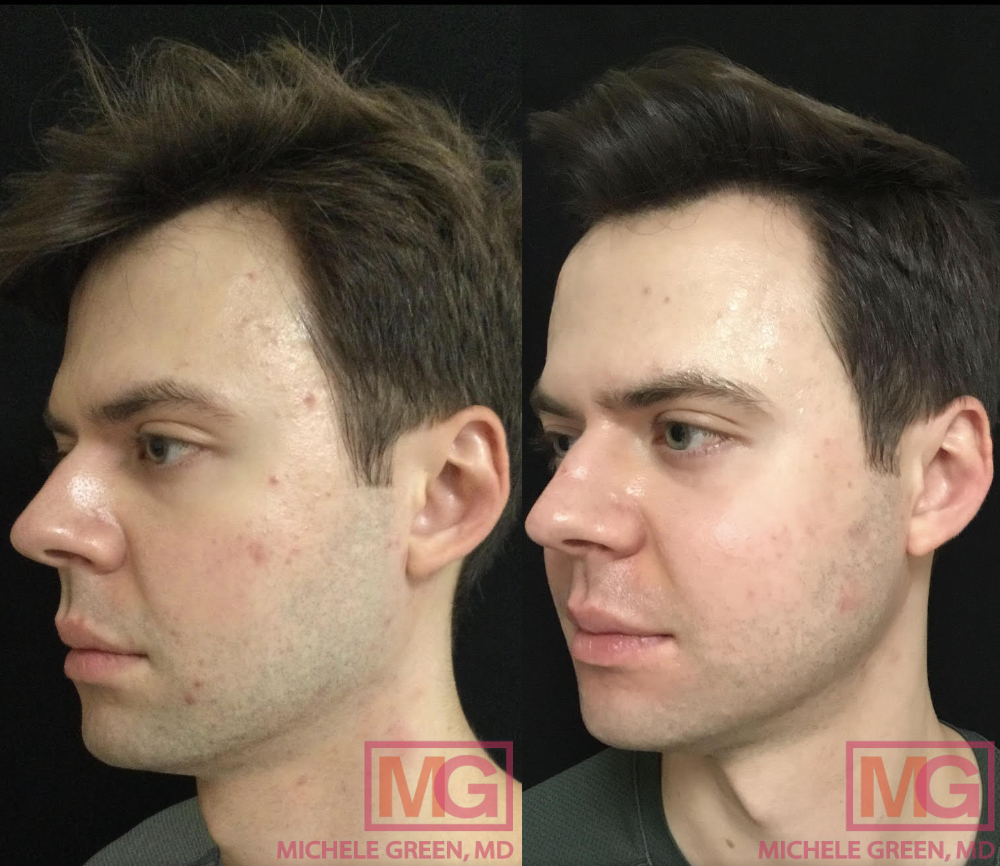
VBeam and eMatrix for Acne Scars before and after
- TCA Cross – Trichloroacetic acid (TCA) cross is a chemical solution applied directly to atrophic acne scars to boost collagen and elastin production for firmer, smoother skin. This acne scar treatment is effective for ice-pick scars, rolling acne scars, and boxcar scars, with the aim of raising the skin and reducing the visibility of depressed scars. However, this treatment should be avoided for patients with darker skin tones due to a higher risk of unwanted side effects, such as hyperpigmentation.
- Chemical Peels – Chemical peels are non-invasive treatments that improve skin texture and tone. They use chemical exfoliants to boost collagen production and speed up skin cell turnover, removing dead skin to reveal healthier new cells. Chemical peels can be superficial, medium-depth, or deep. Dr. Green often chooses a superficial or medium-depth peel, depending on the severity of the acne scars. Trichloroacetic acid (TCA) peels effectively remove dead skin cells to gently resurface the skin and improve the look of depressed acne scars. Mesopeels are chemical peels with skin-brightening ingredients like tranexamic acid, used to treat post-inflammatory hyperpigmentation from previous acne. Typically, a series of three to six chemical peels is recommended for best results in reducing acne scars.
- Microneedling – Microneedling, also known as collagen induction therapy, is a non-invasive cosmetic procedure designed to improve the appearance of acne scars, uneven skin texture, fine lines, wrinkles, and pore size. During treatment, tiny surgical-grade needles create micro-injuries in the epidermis, prompting the skin’s natural healing process and the production of new collagen. The microchannels also improve the absorption of topical products, enhancing the effects of targeted serums. Patients with post-inflammatory hyperpigmentation from acne scars can use a depigmentation serum during treatment to gradually lighten scars and even skin tone. They can also incorporate platelet-rich plasma (PRP), which contains numerous growth factors and proteins that speed up collagen growth for faster, more noticeable results. PRP, derived from the patient’s blood, is completely safe to use during microneedling. Usually, patients need a series of at least three sessions spaced one month apart for optimal results.
- Punch Excision – Punch excision is a minimally invasive procedure used for deep ice-pick scars when subcision alone isn’t sufficient. It involves using a punch tool to remove the scar by making a small circular cut to excise the tissue. After removing the scar, the skin is sutured together, resulting in a linear scar that will fade over time. This technique is ideal for deeper, tethered scars but is more invasive than subcision. Sutures are removed after one week, and the resulting scar is more superficial and will fade over time.
Microneedling vs. Subcision:
Microneedling and subcision are both effective options for reducing the appearance of acne scars. Microneedling stimulates the skin’s natural healing process to produce new collagen, which enhances skin texture and minimizes fine lines and wrinkles. Subcision is a procedure that breaks apart scar tissue beneath depressed acne scars and is often combined with dermal fillers to restore volume and create a smoother skin surface. Microneedling is ideal for patients with skin texture irregularities who want to improve mild to moderate acne scars. Subcision with dermal fillers is best for patients experiencing volume loss due to depressed acne scars. Since patients often have different types of acne scars, Dr. Green frequently uses a combination of procedures in her patients’ treatment plans to achieve a clear, smooth complexion. During your initial consultation with Dr. Green, she will help you determine the most effective treatment option for you.
How many sessions of subsicion are needed for acne scars?
Although some patients may notice a difference after just one treatment session, multiple sessions are necessary for optimal results. Dr. Green advises that patients with moderate to severe acne scars undergo between three and six treatment sessions, each spaced four to six weeks apart. The cosmetic improvements will be long-lasting once the full series of treatments is completed.
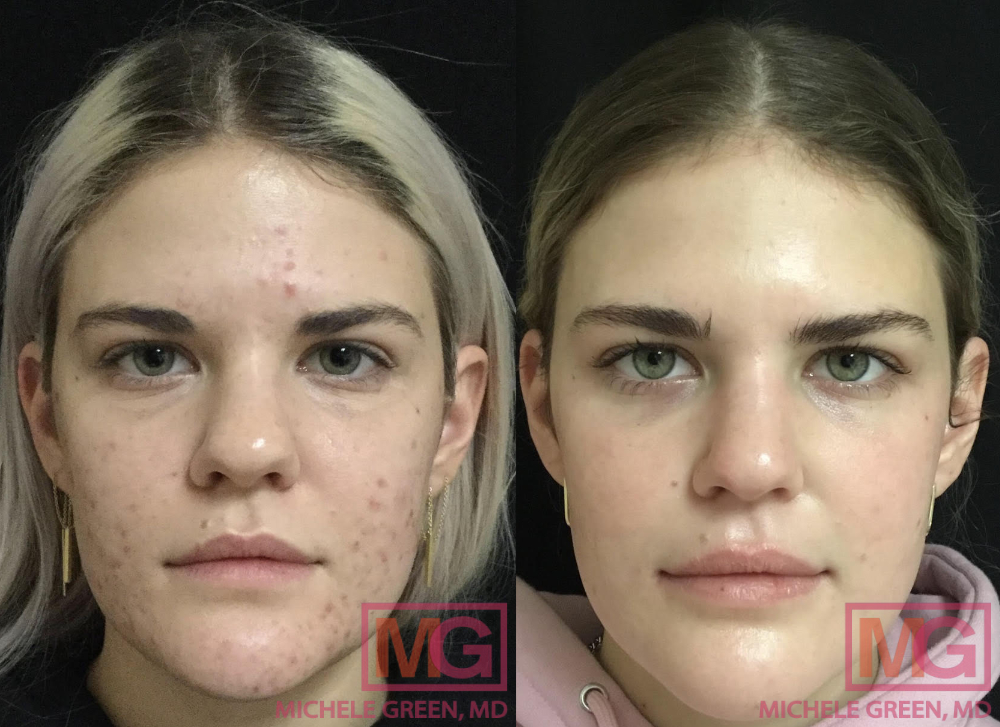
Frequently Asked Questions (FAQs) for acne scar subcision treatment:
Is subcision safe on acne scars?
Yes, subcision is a safe and effective method for treating depressed and tethered acne scars. However, it is a minimally invasive surgical procedure that requires proper medical supervision and can cause some side effects. These include bruising, swelling, infection, and temporary discomfort, with less common risks such as nerve damage, scarring, or blood clots also possible. Although subcision for acne scars may be offered at various medical spas and clinics, since it is a surgical procedure, it is best to consult an experienced, board-certified dermatologist like Dr. Michele Green to minimize potential complications and risks.
Does microneedling or subcision get rid of acne scars permanently?
Subcision involves inserting a hypodermic needle and moving it in a fanning motion to break up the fibrous bands that tether the skin’s surface to the underlying tissue. Once these fibrotic strands are broken, there is an immediate “lifting” of the skin, which reduces the appearance of depressed acne scars and creates a smoother look. Results will continue to improve over time as the procedure also stimulates collagen production, further enhancing skin texture. The effects of subcision are permanent because the fibrotic scar tissue strands are destroyed. Collagen production from microneedling is also long-lasting. However, since collagen production naturally declines over time, repeat treatments may be needed to maintain the results.
Can subcision cause hyperpigmentation?
Subcision should not cause hyperpigmentation and should help reduce the appearance of acne scars. However, post-inflammatory hyperpigmentation from acne lesions can be treated with various cosmetic procedures. At Dr. Green’s dermatology office, options like microneedling, chemical peels, and laser therapy focus on surface hyperpigmentation to improve skin tone and texture. Patients with post-inflammatory hyperpigmentation from acne scars can use a depigmentation serum during microneedling to gradually lighten the scars.
How much does acne subcision cost?
The cost of acne scar treatment with subcision varies depending on several factors. These include the experience level of the doctor performing the procedure, the location of the medical office, and the severity of the scars needing treatment. Patients with more severe scars may require additional subcision sessions. When dermal fillers like Juvederm, Restylane, or Sculptra are used along with subcision, the cost includes the price of these fillers, based on the amount needed. It’s important to choose a provider with the right knowledge, experience, and skill to ensure excellent results. During your consultation with Dr. Green, we will discuss the best type and amount of dermal fillers to complement your treatment, along with the total cost.
Can subcision cause acne scars?
The main cause of acne scars is skin damage from inflammation due to acne breakouts; therefore, subcision will not create new scars. Subcision is a treatment designed to improve acne scars by breaking the fibrous bands that pull scar tissue downward, creating a depression in the skin. This process helps the skin lift, relax, and start collagen production for a smoother appearance. After the treatment, you’ll notice an immediate “lifting” effect as the scar is no longer anchored to the scar tissue. New acne scars will only form if active acne lesions develop on the skin’s surface. If you’re experiencing active breakouts, it’s best to consult with a board-certified dermatologist like Dr. Green to treat the breakouts first and prevent future scarring, which can be harder to treat.
Can subcision make scars worse?
Subcision is a procedure used to treat specific types of acne scars. It should not worsen scars and should actually help reduce their appearance by breaking up the fibrous bands that pull the skin down, creating the depth of an acne scar. This treatment also encourages collagen production, so as the skin produces more collagen over time, the scars should become less visible. Since this is a surgical procedure with potential side effects and risks, it is recommended to see a board-certified dermatologist, like Dr. Green, to ensure proper technique and treatment to prevent further skin damage.
Is acne subsicion painful?
Subcision for acne scars is usually not painful. An hour before the procedure, Dr. Green will have patients apply a topical local anesthetic to numb the area and help prevent discomfort. The numbing cream should be applied to freshly cleaned skin and will be removed just before the treatment starts. Most patients do not experience significant pain during the procedure. Additionally, there is the tumescent subcision method, which offers a more comfortable experience. Tumescent anesthesia involves injecting a large volume of a diluted local anesthetic solution into the skin, helping lift the skin and making it easier to release scar tissue with the subcision technique. This results in a more comfortable and effective treatment for acne scars. Recovery time is minimal, and common side effects like bruising, swelling, and tenderness are usually mild and resolve within a week.
How long does it take for a subcision to heal?
Subcision acne scar treatment is a minor surgical procedure with minimal downtime and a quick recovery period. In the days following the treatment, patients might experience mild side effects such as bruising, swelling, and tenderness at the treatment site. However, these usually resolve on their own within a week. Most patients find they are fully healed from the procedure one week after the session.
Does subcision really work for acne scars?
Yes. Subcision is an effective treatment for depressed acne scars, especially boxcar and rolling scars. Researchers have shown that subcision can permanently reduce the appearance of acne scars. One study found that 90% of participants saw a noticeable improvement in their skin texture after treatment. Results may improve when combined with other options, such as dermal fillers or laser resurfacing. The International Journal of Research in Medical Sciences published research in 2016 that showed subcision was the most successful among three common acne scar treatments: subcision, CO2 fractional lasers, and derma rollers. To find the best treatment plan for you, schedule your initial consultation with Dr. Green.
Is subcision worth it?
Subcision is a great treatment for depressed acne scars. It is highly effective, minimally invasive, and often works best when combined with dermal filler injections. On average, subcision improves the appearance of acne scars by over 60%. However, Dr. Green usually pairs subcision with other cosmetic procedures, such as dermal fillers and cosmetic lasers, to achieve the best results. While subcision can be very successful, it’s important to consult a board-certified dermatologist to see if it’s right for you.
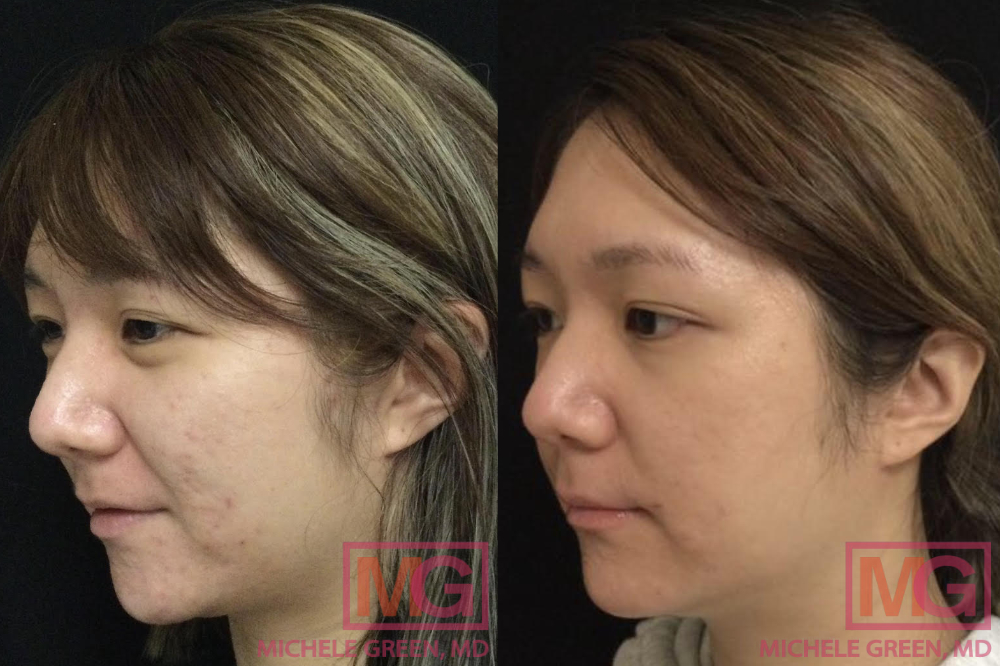
How to get started with subcision acne scar treatment today
Acne scars can be difficult to treat, and many patients may feel self-conscious about their appearance. Fortunately, there are many effective options for acne scar revision available at Dr. Michele Green’s private dermatology clinic in New York City, including subcision with dermal fillers and advanced laser treatments. If you’re concerned about your acne scars and want to learn which treatments will yield the best results for your skin type, tone, and scar nature, schedule a consultation with Dr. Green today.
Dr. Green is an internationally renowned, board-certified dermatologist with over 25 years of experience providing her patients worldwide with top non-invasive treatments, including options for acne scars. Recognized for her dedication and expertise, she is consistently ranked as one of NYC’s best dermatologists by Castle Connolly, New York Magazine, Super Doctors, and The New York Times. Dr. Green takes a holistic approach and follows a ‘less is more’ philosophy, helping her patients achieve and maintain their ideal aesthetic goals to look and feel like the best version of themselves. As a specialist in cosmetic dermatology with a focus on reducing the appearance of acne scars, Dr. Green is your expert guide to attaining smooth, clear, and beautiful skin that endures. Contact us online today or call 212-535-3088 to schedule a consultation with Dr. Green, learn more about her unique method of subcision for textural acne scars, and discover which acne scar treatments would be best for you.
 212-535-3088
212-535-3088 